India Travel Journal: Rajasthan East
| This travel journal is part of a series of journals, which are all written during a long trip between november 2007 and may 2009. |
> Jaipur
17-11-2008 As the Indian trains are riding continuous for twentyfour hours, we have been blessed with the wonderful departure time of 6 a.m., meaning we have to get up in the middle of the night. Unfortunately our good behaviour is not being rewarded, as the original delay of one hour eventually becomes two and it's well past eight when we finally leave.
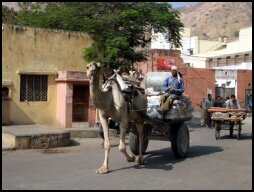 We're happy to find out the ride doesn't take as long as we expected and in the early afternoon we arrive in Jaipur. Jaipur, the place where people obviously take a camel instead of a bicyle or motorbike to get down to work. The animals are everywhere to be seen and they take part in traffic like they never did something else.
We're happy to find out the ride doesn't take as long as we expected and in the early afternoon we arrive in Jaipur. Jaipur, the place where people obviously take a camel instead of a bicyle or motorbike to get down to work. The animals are everywhere to be seen and they take part in traffic like they never did something else.
18-11-2008 Unfortunately last night our sleep has been stolen once more, this time by five mosquitoes and a mattrass as hard as a plank. We're all stiff and our muscles ache and we don't feel like staying here any longer. So first we move to the neighbours, who did invest some money in soft mattrasses and then we walk into the city.
Jaipur seems to be much cleaner than everything we've seen from India so far, but on the other hand there are many more streetkids. They are sleeping under thin blankets on a busy roundabout, are digging for food in trash cans and pull the sleeves of tourists who look down their noses at them and quickly turn a blind eye.
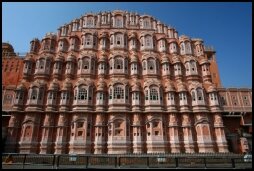 The old city of Jaipur is magical. The pink-red buildings look fairytale-like, even though many of them are a bit decayed. Hawa Mahal, or the Palace of the Wind, is just being renovated and is obviously the best-looking building of the city. We climb the five story building and are able to see from up close how the women in ancient times have been hiding themselves behind tiny little windows here, to catch a glimpse of the streetlife.
The old city of Jaipur is magical. The pink-red buildings look fairytale-like, even though many of them are a bit decayed. Hawa Mahal, or the Palace of the Wind, is just being renovated and is obviously the best-looking building of the city. We climb the five story building and are able to see from up close how the women in ancient times have been hiding themselves behind tiny little windows here, to catch a glimpse of the streetlife.
We climb a hill in the outskirts of the city to check out the Monkey Temple, but that's a rather disappointing place.
Back in the old city we stroll along the many shops, most of them not much bigger than a few square meters. It's incredibly busy here. Veiled women in black are looking for a new handbag or children's clothes, women in saris with all the clolours of the rainbow are walking in between to buy fresh vegetables or fruit, kids are being dragged along or carried, while the men are looking around in shops selling spare parts or the latest video-cds with cool Indian music. The little restaurants are full as well, serving people fried snacks and colourful shakes. Many of the shops and restaurants are drawing our attention, showing things we've never seen before. We see products of which we had no idea they even existed, let alone we have the slightest idea of what one should use them for.
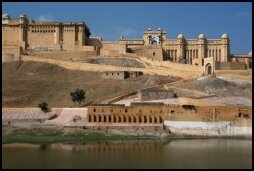 19-11-2008 The Amber Fort, about ten kilometers outside Jaipur, is a huge palace, surrounded with walls that even the Chinese would find impressive. We check out the fort from the inside and the outside, keeping us occupied for almost a whole day, since the place is so huge.
19-11-2008 The Amber Fort, about ten kilometers outside Jaipur, is a huge palace, surrounded with walls that even the Chinese would find impressive. We check out the fort from the inside and the outside, keeping us occupied for almost a whole day, since the place is so huge.
20-11-2008 Right after our visit to the mausoleums of the various Maharajas we meet Janneke, an Australian girl who's luxuriously traveling around in an Ambassador with driver. With her we go visit Nahargarh Fort, situated on a hill high above the city, offering a great panorama of Jaipur. Once again it's a magnificent building with lots of colourful paintings. In style the old English car drops us in the middle of the old city, where we buy a souvenir.
> To Pushkar
21-11-2008 By bus we move on to Pushkar and when we're driving out of Jaipur we say to each other once more that India's such an interesting country. It's like a cool party here, every day again. On the highway we're overtaken by colourfully painted trucks with Christmas decorations on their mirrors and lights behind their windshields. In the village of Pushkar the most bizarrely dressed Sadhus are walking around and the saris of the women are more colourful than on an avarage carnival. In the evening there's a procession passing our hotel, putting many raves in the shade for both light and sound levels. And then we haven't even mentioned the singing and dancing at the temples around the Pushkar Lake.
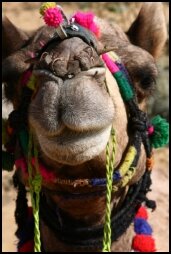 Camels are lazily ruminating in the afternoon sunshine and together with the sandy streets they are contributing to the real desert athmosphere of this village. The temples and other colourful buildings are a bright contrast to the clear blue sky. We walk around a bit, but soon we're tired. Even in a small town like Pushkar there's so much to see, hear and smell on every single square meter.
Camels are lazily ruminating in the afternoon sunshine and together with the sandy streets they are contributing to the real desert athmosphere of this village. The temples and other colourful buildings are a bright contrast to the clear blue sky. We walk around a bit, but soon we're tired. Even in a small town like Pushkar there's so much to see, hear and smell on every single square meter.
22-11-2008 We'd wish we could start with: "after a good night's sleep...", but that would be a terrible lie. Last night a long procession of revelers passed our hotel, drumming loud and accompanied by a synthesizer. About a hundred meters further down the road they enetered the festival grounds, where loud rave music was played until after midnight. When it was finally quiet the stray dogs thought they also deserved some notice and as early as four a.m. the first tractor of the village passed our door. At seven the neighbours were checking out under a cacaphony of babbling and laughter, so we're in bed until after ten. Now that it's finally quiet we're too numb to move.
After a late breakfast we go out, trying to find the Shakti project, about which we've been reading on the internet. Shakti means "power" and tries to send streetkids and kids from extremely poor families to school, to get the education they usually wouldn't be able to get. At Shakti they get a helping hand with their homework and a meal. Tuition and uniforms are payed for the kids by the foundation. At this moment there are 62 kids who are being helped this way and five whizzes have the privilege to attend private school. This means they have to share a classroom with maximum twenty kids instead of at least fourty at government schools. They also don't have to share their books with five or more kids, but only with two or three.
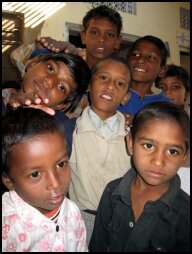 We can't find Shakti right away and after asking around a bit and some serious exploration in Pushkar our collars get felt by a friend of the caretaker, who accompanies us to the right building. Ramsingh is called and we have a chat about the way the foundation works and how we could contribute. The athmosphere and the way everything is organised here are to our liking and we agree to return on monday when the kids are there too. We think we'll be helping out here for the next week or two.
We can't find Shakti right away and after asking around a bit and some serious exploration in Pushkar our collars get felt by a friend of the caretaker, who accompanies us to the right building. Ramsingh is called and we have a chat about the way the foundation works and how we could contribute. The athmosphere and the way everything is organised here are to our liking and we agree to return on monday when the kids are there too. We think we'll be helping out here for the next week or two.
During lunch at an eatery we become acquainted with the animal world of Pushkar. Hundreds of flies are circling the place, one of the consequences of the nice open sewers here. The tickling feeling at our feet turns out to be a rat, which quickly runs off as soon as we spot him. One of the many cows also comes to meet us at our table, sucking Peters t-shirt for a moment. The outdoor feeling completely emerges here in India.
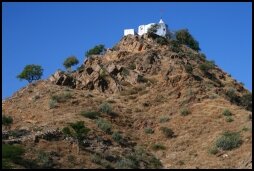 In the late afternoon we walk to the Pap Mochani temple, situated high on a barren hill above town, offering us a nice view of the surrounding landscape.
In the late afternoon we walk to the Pap Mochani temple, situated high on a barren hill above town, offering us a nice view of the surrounding landscape.
> Riding Camels
23-11-2008 It's still freezing when we get up early this morning. We have an appointment at eight with Captain, on whose camels we'll be making a tour through the desert. It's still quiet in the village, but Indian pilgrims of all ages are wandring around though, on their way to the temple. Many of them come take a look at us when we're waiting for Captain, who is nowhere to be seen at eight of course. By eight thirty we first go have a cup of warm tea and then the sun is high enough to warm everything and to add a nice red glow.
Our camel man has arrived too. He introduces us to Ali Baba and Raja, our camels, and the two guides who come with us. The camels sink through their knees and we climb on their backs, each accompanied by our own guide. From high above the ground we look out over Pushkar and a bit later over the desert landscape out there. We encounter a funeral procession. The deceased is carried on a stretcher and a hundred or even more men are surrounding and following while chanting. The houses in the outskirts of the village are just some simple huts. In the vicinity dozens of kids are playing, trying to keep some sticks that they found up in the air without using their hands. Cattle is roaming the grounds.
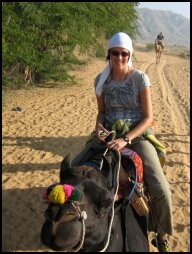 The landscape is pretty, with loose sand, thorny bushes and a few trees. We joggle for almost two hours, before we stop for a break. We're waiting for the cart with our lunch and some other tourists, we hear when we ask for it. It turns out to be an Australian family with three kids. Together we're sitting under a tree, having a chat while our lunch is prepared. Meanwhile we curiously look at all that the cook is doing. We do understand that he's making a woodfire to cook the rice and vegetables, but we get confused by the camel poo that is used to heat some dough balls, without any tinfoil or saucepan... we'd never thought of it ourselves. However, it all tastes delicious.
The landscape is pretty, with loose sand, thorny bushes and a few trees. We joggle for almost two hours, before we stop for a break. We're waiting for the cart with our lunch and some other tourists, we hear when we ask for it. It turns out to be an Australian family with three kids. Together we're sitting under a tree, having a chat while our lunch is prepared. Meanwhile we curiously look at all that the cook is doing. We do understand that he's making a woodfire to cook the rice and vegetables, but we get confused by the camel poo that is used to heat some dough balls, without any tinfoil or saucepan... we'd never thought of it ourselves. However, it all tastes delicious.After another ride through some very beautiful landscapes, with thousands of reed plumes in the ever lower sunlight, we pass through a village. We look around, together with one of the guides and we take advantage of the situation by letting him question the people about all kinds of things and we even take a look inside one of the houses. It all is fairly simple, but exceptionally clean and very neatly painted and taken care of. The women and children keep giggling. They probably don't have white tourists in their houses every day. One of the men also shows up to take a look and even offers us some tea. Even though they have very little, hospitality is, once again, an inborn trait.
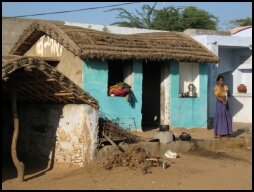
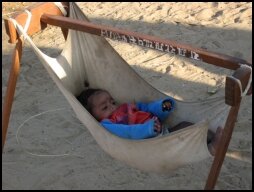
Followed by a large group of screaming and waving kids we leave the village behind and from the top of a sand dune we're just able to enjoy the sunset. Then it's time for the final kilometers back to Pushkar and those are not the easiest ones. With sore asses we roll off our camels and we walk the last painfull meters to our room.
24-11-2008 Despite our sore muscles and with heads feeling like we have a hangover we visit Shakti this morning. First we go for some grocery shopping for the meals of this week with Ramsingh and then... the kids arrive.
Rajasthan streetscenes videoRajasthan streetscenes video will show here |
Pushkar camel trek videoThe Pushkar camel trek video will show here |
Click on the films up here to look around in Rajasthan, almost live.
> More Info
Also check our India info page, where you can find a lot of information about China and come see our Eastern Rajasthan photos.
`